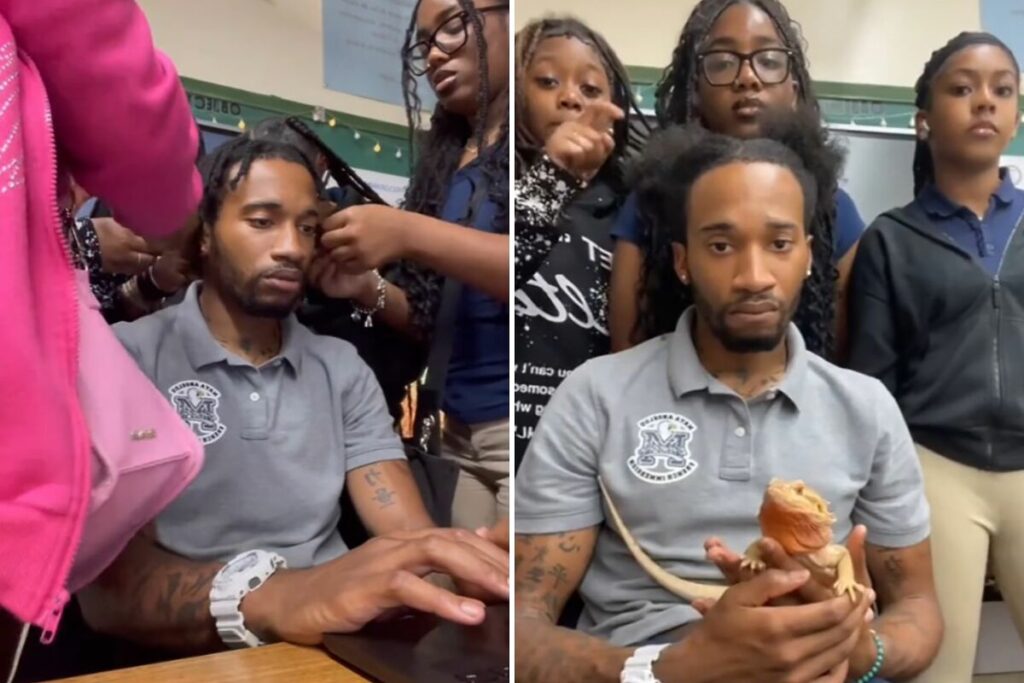
The Trend of Students Unbraiding Teachers’ Hair: A Unique Classroom Bonding Experience
Introduction
In recent years, a unique and heartwarming trend has emerged in classrooms worldwide: students unbraiding their teachers’ hair. While it may sound unconventional, this practice is gaining traction as a symbol of trust, respect, and a positive teacher-student relationship. This article delves into the reasons behind this trend, its implications for the educational environment, and how it is reshaping the traditional roles within the classroom. We will explore the psychological benefits, the cultural significance, and how educators can embrace this trend to foster a more inclusive and supportive learning atmosphere.
The Rise of a Trend: How Students Unbraiding Teachers’ Hair Became Popular
The trend of students unbraiding teachers’ hair has gained attention primarily through social media platforms, where videos and photos of such moments have gone viral. These posts often showcase students carefully unbraiding their teachers’ hair during class, often accompanied by captions that emphasize the trust and camaraderie between the students and their educators.
One reason for the rise in popularity is the shift in educational approaches. Modern classrooms are increasingly focused on creating a more relaxed and collaborative environment. Gone are the days of strict, authoritarian teacher-student dynamics. Today, many educators strive to connect with their students on a personal level, understanding that a positive relationship can enhance learning outcomes. Unbraiding a teacher’s hair symbolizes a breaking down of traditional barriers, allowing students to see their teachers as approachable and human.
Psychological and Emotional Benefits
Building Trust and Respect
One of the most significant benefits of this trend is the building of trust and mutual respect between teachers and students. Unbraiding someone’s hair is an intimate act that requires a level of comfort and trust. When students engage in this activity with their teachers, it signifies that they feel safe and respected in their learning environment. This trust can translate into better classroom behavior, increased participation, and a stronger sense of community within the classroom.
Reducing Stress and Anxiety
The classroom can be a stressful environment for both students and teachers. The act of unbraiding hair can have a calming effect, reducing stress and anxiety for both parties involved. For students, it can be a therapeutic activity that helps them focus and relax, especially in a high-pressure academic setting. For teachers, it offers a moment of relaxation and connection with their students, which can help alleviate the stresses of teaching.
Encouraging Positive Social Interactions
Unbraiding a teacher’s hair in a classroom setting also encourages positive social interactions among students. It provides an opportunity for students to work together, learn about different hair textures and styles, and engage in conversations that go beyond academic topics. This type of interaction fosters a sense of community and belonging, which is crucial for a positive learning environment.
Cultural Significance and Sensitivity
Understanding the Cultural Context
Hair braiding and unbraiding have deep cultural significance in many communities, particularly in African and African-American cultures. It is essential for teachers and students to approach this trend with cultural sensitivity and awareness. In many cultures, hair care is not just a routine task but a tradition passed down through generations, often signifying love, care, and community.
Educators should ensure that the practice of unbraiding hair is voluntary and respectful of the cultural backgrounds of all students. It’s crucial to have open discussions about the cultural significance of hair and hair care practices to avoid misunderstandings or feelings of discomfort.
Promoting Inclusivity and Diversity
Embracing the trend of students unbraiding teachers’ hair can also be a way to celebrate diversity in the classroom. Teachers can use this opportunity to educate students about different hair types, textures, and the cultural importance of hair in various communities. By doing so, educators can promote inclusivity and encourage students to appreciate the beauty of diversity.
How Teachers Can Embrace the Trend
Setting Boundaries and Guidelines
While the trend of students unbraiding teachers’ hair is positive in many ways, it’s essential to set clear boundaries and guidelines. Teachers should communicate with their students about when and how this activity can take place, ensuring that it does not disrupt the learning process. It’s also important to ensure that all students feel comfortable and included, whether they choose to participate or not.
Using It as a Teaching Moment
Teachers can turn this trend into a valuable teaching moment by incorporating lessons about hair care, cultural significance, and respect for personal space. For example, a lesson on the history and cultural importance of braiding in different societies can be both educational and engaging. Teachers can also discuss the importance of consent and personal boundaries, helping students understand that touching someone’s hair is a personal decision.
Encouraging Open Communication
Open communication is key to successfully integrating this trend into the classroom. Teachers should encourage students to express their thoughts and feelings about the activity, ensuring that everyone is comfortable with it. By fostering an environment of open dialogue, teachers can build stronger relationships with their students and create a more inclusive classroom culture.
Potential Challenges and Considerations
Addressing Concerns and Misunderstandings
As with any trend, there are potential challenges and concerns that educators need to address. Some teachers or parents may be uncomfortable with the idea of students unbraiding teachers’ hair, fearing that it could lead to a blurring of professional boundaries. It’s important for educators to address these concerns by explaining the benefits of the activity and ensuring that it is conducted in a respectful and controlled manner.
Maintaining Professionalism
While building a strong rapport with students is important, teachers must also maintain professionalism. It’s crucial to strike a balance between being approachable and upholding the authority that comes with the role of an educator. Teachers should be mindful of how the trend is perceived by others and ensure that it aligns with the overall goals of the educational environment.
Conclusion
The trend of students unbraiding teachers’ hair is more than just a viral sensation; it reflects a broader shift in educational approaches towards fostering trust, respect, and inclusivity in the classroom. By understanding the cultural significance, setting clear boundaries, and using this trend as an opportunity for teaching and bonding, educators can create a more positive and supportive learning environment. While there are challenges to consider, the benefits of this trend—such as building trust, reducing stress, and promoting inclusivity—make it a valuable practice for modern classrooms. As education continues to evolve, trends like this one highlight the importance of human connection and the role it plays in shaping a successful learning experience.




